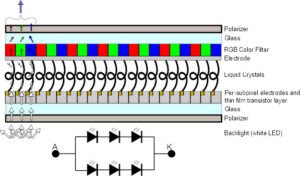RGB
The RGB interface transfers image data using a separate parallel line for each bit of color information. For larger color depths, more lines have to be independently controlled. Each line represents a 2x multiplier on potential colors that can be described. Monochrome displays have just 1-bit color and pixels are either “on” or “off”. A 24-bit data bus includes 8-bits/color meaning that 256 (2^8) possible values for each of Red, Green, and Blue or over 16.7 million (2^24) possible colors.
In addition to 24-bit RGB, there is 18-bit RGB where each color has 6 lines, leading to approximately 262,000 possible colors. There is also R5G6B5 or 565 which describes up to 65,000 colors.
To sync and transfer the RGB data bus of different color lines, RGB also uses HSYNC, VSYNC, DE, and DOTCLK.
One benefit of RGB is the impressive speed at which images can be transferred, especially as the number of pixels being used increases. A draw back of RGB is it requires simultaneous control of a large number of lines. This requires the use of an RGB controller. At Crystalfontz, we use the EVE chip to bring up our RGB displays.
Click here for a list of Crystalfontz RGB displays.
For more on how RGB works, check out our blog post RGB and Color Depth.
